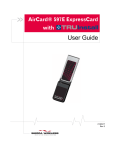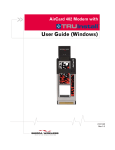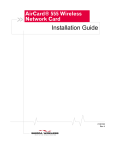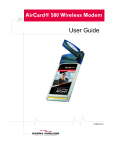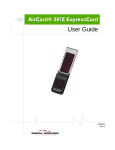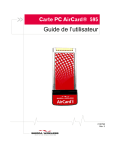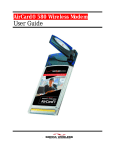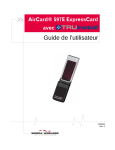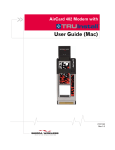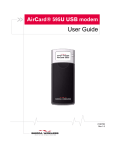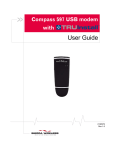Download Sierra Wireless AirCard 580 Installation guide
Transcript
AirCard® 580 Wireless WAN Modem Installation Guide 2130536 Rev 2 Preface Important Notice Due to the nature of wireless communications, transmission and reception of data can never be guaranteed. Data may be delayed, corrupted (i.e., have errors) or be totally lost. Although significant delays or losses of data are rare when wireless devices such as the Sierra Wireless modem are used in a normal manner with a well‐constructed network, the Sierra Wireless modem should not be used in situations where failure to transmit or receive data could result in damage of any kind to the user or any other party, including but not limited to personal injury, death, or loss of property. Sierra Wireless accepts no responsibility for damages of any kind resulting from delays or errors in data transmitted or received using the Sierra Wireless modem, or for failure of the Sierra Wireless modem to transmit or receive such data. Safety and Hazards Do not operate the Sierra Wireless modem in areas where blasting is in progress, where explosive atmospheres may be present, near medical equipment, near life support equipment, or any equipment which may be susceptible to any form of radio interference. In such areas, the Sierra Wireless modem MUST BE POWERED OFF. The Sierra Wireless modem can transmit signals that could interfere with this equipment. Do not operate the Sierra Wireless modem in any aircraft, whether the aircraft is on the ground or in flight. In aircraft, the Sierra Wireless modem MUST BE POWERED OFF. When operating, the Sierra Wireless modem can transmit signals that could interfere with various onboard systems. Note: Some airlines may permit the use of cellular phones while the aircraft is on the ground and the door is open. The Sierra Wireless modem may be used at this time. The driver or operator of any vehicle should not operate the Sierra Wireless modem while in control of a vehicle. Doing so will detract from the driver or operatorʹs control and operation of that vehicle. In some states and provinces, operating such communications devices while in control of a vehicle is an offence. Limitation of Liability Rev 2 Mar.11 The information in this manual is subject to change without notice and does not represent a commitment on the part of Sierra Wireless. SIERRA WIRELESS AND ITS AFFILIATES SPECIFICALLY DISCLAIM LIABILITY FOR ANY AND ALL DIRECT, INDIRECT, SPECIAL, GENERAL, INCIDENTAL, CONSEQUENTIAL, PUNITIVE OR EXEMPLARY DAMAGES INCLUDING, BUT NOT LIMITED TO, LOSS OF PROFITS OR 1 AirCard® 580 Wireless WAN Modem - Installation Guide REVENUE OR ANTICIPATED PROFITS OR REVENUE ARISING OUT OF THE USE OR INABILITY TO USE ANY SIERRA WIRELESS PRODUCT, EVEN IF SIERRA WIRELESS AND/OR ITS AFFILIATES HAS BEEN ADVISED OF THE POSSIBILITY OF SUCH DAMAGES OR THEY ARE FORESEEABLE OR FOR CLAIMS BY ANY THIRD PARTY. Notwithstanding the foregoing, in no event shall Sierra Wireless and/or its affiliates aggregate liability arising under or in connection with the Sierra Wireless product, regardless of the number of events, occurrences, or claims giving rise to liability, be in excess of the price paid by the purchaser for the Sierra Wireless product. Patents This product may contain technology developed by or for Sierra Wireless Inc. This product includes technology licensed from QUALCOMM® 3G. This product is manufactured or sold by Sierra Wireless Inc. or its affiliates under one or more patents licensed from Inter‐ Digital Group. Copyright 2 ©2011 Sierra Wireless. All rights reserved. 2130536 Preface Trademarks AirCard and “Heart of the Wireless Machine” are registered trademarks of Sierra Wireless. Sierra Wireless, the Sierra Wireless logo, the red wave design, the red‐tipped antenna, and Watcher are trademarks of Sierra Wireless. Windows® is a registered trademark of Microsoft Corporation. QUALCOMM® is a registered trademark of QUALCOMM Incorporated. InstallShield® is a registered trademark and service mark of InstallShield Corporation. Other trademarks are the property of the respective owners. Comments Sales Desk: Phone: 1-604-232-1488 Hours: 8:00 AM to 5:00 PM Pacific Time E-mail: [email protected] Post: Sierra Wireless 13811 Wireless Way Richmond, BC Canada V6V 3A4 Fax: 1-604-231-1109 Web: www.sierrawireless.com Your comments and suggestions on improving this documen‐ tation are welcome and appreciated. Please e‐mail your feedback, noting document 2130536 Rev 2, to [email protected]. Thank you. Consult our website for up‐to‐date product descriptions, documentation, application notes, firmware upgrades, trouble‐ shooting tips, and press releases: www.sierrawireless.com Rev 2 Mar.11 3 AirCard® 580 Wireless WAN Modem - Installation Guide 4 2130536 Table of Contents Introducing the AirCard® 580 Wireless WAN Modem . . . . . . . . . . . . . . . . . . . .7 Welcome. . . . . . . . . . . . . . . . . . . . . . . . . . . . . . . . . . . . . . . . . . . . . . . . . . . . . . . . . . 7 Feature summary . . . . . . . . . . . . . . . . . . . . . . . . . . . . . . . . . . . . . . . . . . . . . . . . . . Wireless WAN modem . . . . . . . . . . . . . . . . . . . . . . . . . . . . . . . . . . . . . . . . . . CDMA 3G services . . . . . . . . . . . . . . . . . . . . . . . . . . . . . . . . . . . . . . . . . . . . . . Additional AirCard features . . . . . . . . . . . . . . . . . . . . . . . . . . . . . . . . . . . . . . 7 8 8 9 Package contents . . . . . . . . . . . . . . . . . . . . . . . . . . . . . . . . . . . . . . . . . . . . . . . . . . 9 System components . . . . . . . . . . . . . . . . . . . . . . . . . . . . . . . . . . . . . . . . . . . . . . . . 9 Your host computing device . . . . . . . . . . . . . . . . . . . . . . . . . . . . . . . . . . . . . . 9 The AirCard 580 wireless WAN modem . . . . . . . . . . . . . . . . . . . . . . . . . . . 10 The AirCard drivers and enabling software . . . . . . . . . . . . . . . . . . . . . . . . 10 A CDMA service provider account . . . . . . . . . . . . . . . . . . . . . . . . . . . . . . . . 10 The CDMA wireless network . . . . . . . . . . . . . . . . . . . . . . . . . . . . . . . . . . . . 11 Getting Started . . . . . . . . . . . . . . . . . . . . . . . . . . . . . . . . . . . . . . . . . . . . . . . . . . . . .13 The AirCard 580 software. . . . . . . . . . . . . . . . . . . . . . . . . . . . . . . . . . . . . . . . . . . 13 Account activation and configuration . . . . . . . . . . . . . . . . . . . . . . . . . . . . . . . . 13 Installation . . . . . . . . . . . . . . . . . . . . . . . . . . . . . . . . . . . . . . . . . . . . . . . . . . . . . . . . .15 System requirements . . . . . . . . . . . . . . . . . . . . . . . . . . . . . . . . . . . . . . . . . . . . . . 15 AirCard software installation procedures . . . . . . . . . . . . . . . . . . . . . . . . . . . . . 16 Card insertion and removal . . . . . . . . . . . . . . . . . . . . . . . . . . . . . . . . . . . . . . . . . 18 Inserting the AirCard . . . . . . . . . . . . . . . . . . . . . . . . . . . . . . . . . . . . . . . . . . . 18 Removing the AirCard . . . . . . . . . . . . . . . . . . . . . . . . . . . . . . . . . . . . . . . . . . 18 Activation . . . . . . . . . . . . . . . . . . . . . . . . . . . . . . . . . . . . . . . . . . . . . . . . . . . . . . . . . .19 Account configuration procedures. . . . . . . . . . . . . . . . . . . . . . . . . . . . . . . . . . . 19 Activation Wizard . . . . . . . . . . . . . . . . . . . . . . . . . . . . . . . . . . . . . . . . . . . . . . 19 Manual activation . . . . . . . . . . . . . . . . . . . . . . . . . . . . . . . . . . . . . . . . . . . . . . . . . 20 Rev 2 Mar.11 5 AirCard® 580 Wireless WAN Modem - Installation Guide Automated activation . . . . . . . . . . . . . . . . . . . . . . . . . . . . . . . . . . . . . . . . . . . . . . 20 Care and Maintenance of Your AirCard . . . . . . . . . . . . . . . . . . . . . . . . . . . . . . . .23 Watcher Basics . . . . . . . . . . . . . . . . . . . . . . . . . . . . . . . . . . . . . . . . . . . . . . . . . . . . .25 Starting and closing Watcher . . . . . . . . . . . . . . . . . . . . . . . . . . . . . . . . . . . . . . . 25 Components of the Watcher window. . . . . . . . . . . . . . . . . . . . . . . . . . . . . . . . . Window controls . . . . . . . . . . . . . . . . . . . . . . . . . . . . . . . . . . . . . . . . . . . . . . Docking . . . . . . . . . . . . . . . . . . . . . . . . . . . . . . . . . . . . . . . . . . . . . . . . . . . . . . Always On Top . . . . . . . . . . . . . . . . . . . . . . . . . . . . . . . . . . . . . . . . . . . . . . . . 26 26 27 27 Interpreting icons . . . . . . . . . . . . . . . . . . . . . . . . . . . . . . . . . . . . . . . . . . . . . . . . . Connection Status Area . . . . . . . . . . . . . . . . . . . . . . . . . . . . . . . . . . . . . . . . Call Status Area . . . . . . . . . . . . . . . . . . . . . . . . . . . . . . . . . . . . . . . . . . . . . . . Indicator area . . . . . . . . . . . . . . . . . . . . . . . . . . . . . . . . . . . . . . . . . . . . . . . . . Minimized Icons . . . . . . . . . . . . . . . . . . . . . . . . . . . . . . . . . . . . . . . . . . . . . . . 27 28 29 30 30 Online Help . . . . . . . . . . . . . . . . . . . . . . . . . . . . . . . . . . . . . . . . . . . . . . . . . . . . . . 31 Troubleshooting . . . . . . . . . . . . . . . . . . . . . . . . . . . . . . . . . . . . . . . . . . . . . . . . . . 31 Technical Specifications . . . . . . . . . . . . . . . . . . . . . . . . . . . . . . . . . . . . . . . . . . . .33 LED operation . . . . . . . . . . . . . . . . . . . . . . . . . . . . . . . . . . . . . . . . . . . . . . . . . . . . 33 Radio frequency and electrical specifications . . . . . . . . . . . . . . . . . . . . . . . . . 33 Environmental specifications . . . . . . . . . . . . . . . . . . . . . . . . . . . . . . . . . . . . . . . 34 Glossary . . . . . . . . . . . . . . . . . . . . . . . . . . . . . . . . . . . . . . . . . . . . . . . . . . . . . . . . . . .35 Index . . . . . . . . . . . . . . . . . . . . . . . . . . . . . . . . . . . . . . . . . . . . . . . . . . . . . . . . . . . . . .39 6 2130536 1: Introducing the AirCard® 580 Wireless WAN Modem • Welcome • Feature summary • Package contents Note: Do not insert the AirCard into your PC Card slot prior to installing the software. It is important to install the software and driver in the correct order. For detailed procedures, see page 15. 1 Welcome The Sierra Wireless AirCard 580 wireless WAN modem is a dual‐band wireless PC Card for cellular and North American PCS networks. It enhances the functionality of your mobile computing device by adding wireless data and 2‐way messaging. This card allows you to do the following (subject to feature availability), without using a wireline phone or network: • Connect to the Internet, VPN and corporate networks • Send and receive e‐mail • Send and receive SMS messages The software provided with the AirCard also allows you to manage and monitor connections with a WiFi network adapter. Note: You can view this guide online or print it to keep on hand. If you're viewing it online, simply click a topic in the Table of Contents, or a page number in the Index, or any page reference or section reference. (Most text that is blue is a clickable link.) The PDF automatically displays the appropriate page. Feature summary Note: For step-by-step instructions to access features of the AirCard, consult the online help available with Watcher™ (page 31). Rev 2 Mar.11 The AirCard is designed to provide a wide range of capabil‐ ities using CDMA network technology. Implementation of these features depends on the particular service provider and account features you have chosen. Some features described in this manual may not be supported by your service provider or may not be available with your network account. For details of the services and accounts available, contact your service provider. 7 AirCard® 580 Wireless WAN Modem - Installation Guide Wireless WAN modem Once installed and configured, the AirCard can connect to the CDMA network automatically. You just insert the AirCard, allow Watcher to autolaunch and authenticate your account on the network, then launch your Internet browser—you’re online! As a modem, the AirCard also allows you to dial up any other modem (such as a corporate server). CDMA 3G services The AirCard operates over a type of wireless network called CDMA (Code Division Multiple Access). CDMA 3G technology provides a variety of connectivity features, depending on your service provider and account: • 1x‐EVDO supports Internet connections with data rates up to 2.4 Mbps (downlink from the network) and 153.6 kbps (uplink to the network). Average data rates are roughly 700 kbps (downlink from the network) and 153.6 kbps (uplink to the network). Actual speed depends on the network conditions. • 1X supports Internet connections with data rates up to 153.6 kbps (downlink from the network) and 76.8 kbps (uplink to the network). Actual speed depends on the network conditions. Once the connection is established, you can open your browser and connect to any web site that is accessible through the Internet, or access other Internet services (such as e‐mail). The connection is “active” when data transmission is occurring. If data transmission stops for a period of time (determined by the network), the connection becomes “dormant”; see page 29. 8 • Circuit switched (dial‐up) data, using the earlier CDMA IS‐95 specification, supports data connections to any dial‐ in service at rates up to 14.4 kbps. • QNC (Quick Net Connect), provides a simplified way to dial into an Internet connection (using circuit switched data) where 3G (1xEV‐DO or 1X) high‐speed packet service is not available. • SMS (Short Message Service), allows you to send and receive short text messages using the AirCard. 2130536 Introducing the AirCard® 580 Wireless WAN Modem Additional AirCard features Beyond the features of the CDMA network, the AirCard provides additional software features: • PIN security code to protect your AirCard and account from unauthorized use. • An Activation Wizard (page 19) to assist with configuring your CDMA account. • Sound options to customize ringtones for incoming calls, SMS messages. • A Call Log to track incoming, outgoing, missed calls and determine the amount of data transferred. • Ability to manage and monitor connections with a WiFi network adapter. Package contents Your AirCard package contains the following components: • AirCard 580 wireless WAN modem with antenna • Installation CD containing the AirCard software and this installation and troubleshooting guide • Quick Start Guide • Warranty Card System components Your AirCard 580 wireless WAN modem is just one part of a system designed to provide you with a wide range of commu‐ nication features. Every component of the system is needed to enable these capabilities. Your host computing device Your notebook hosts the AirCard hardware and runs the communication software: your web browser or e‐mail appli‐ cation, and Watcher—the AirCard enabling software. You may also have other software on your computer that can be used wirelessly with the AirCard, such as: file transfer applications (FTP), chat or instant messaging, a VPN (Virtual Private Network) client, client software for a corporate server application. Rev 2 Mar.11 9 AirCard® 580 Wireless WAN Modem - Installation Guide The AirCard 580 wireless WAN modem Along with the antenna, this equips your computer with a radio modem. The AirCard fits into a standard Type II PC Card slot available on most notebook PCs. Every CDMA network operates on one of three radio frequency bands. As a dual‐band product, the AirCard operates on two of these bands (see page 33), providing a wide coverage area. The AirCard drivers and enabling software Required to control, monitor, and manage your wireless connections, this includes the Watcher application, and the Network Adapter Manager for selecting your network connection card. The AirCard comes with a CD containing this software: • Watcher application that you use to manage the AirCard and monitor your connections. For step‐by‐step instruc‐ tions to access features of Watcher, use the application’s online help. • Network Adapter Manager application that allows you to switch between the AirCard and network cards. This application also handles the autolaunch of Watcher when you insert the AirCard. • The device driver software that enables the AirCard to work with your computer’s operating system. The driver and application software must be installed before you insert the AirCard for the first time. Detailed instructions are provided in the following chapters. A CDMA service provider account Companies that operate CDMA networks and provide access to these networks are called service providers. To use the AirCard, you must have an account with a CDMA service provider. 10 2130536 Introducing the AirCard® 580 Wireless WAN Modem Note: You can use the Lock Code feature to prevent others from using your account should your AirCard be stolen. For information on this feature, see the online help. Each service provider has its own pricing options. There may be flat rate accounts, which provide you a maximum number of minutes of network usage for a fixed monthly fee. There may be accounts for which you are charged for network usage by the minute or by the amount of data transmitted. Your account may include a variety of other services such as SMS messaging. Each AirCard has been provisioned at the factory for use with a particular service provider. This sets the AirCard to use particular radio channels and enables services specific for that provider. The process of setting up your account is called activation. Activation involves action by the service provider and configu‐ ration of the AirCard. The procedure to configure (activate) your AirCard is covered in “Activation” on page 19. The CDMA wireless network Note: More information about CDMA networks is available on the CDMA Development Group web site, www.cdg.org. This is the worldwide infrastructure providing the radio coverage that allows you to stay connected. Made up of radio towers and a variety of network switches, routers, and servers, the network is an interconnection of many service providers. Note: Most service providers have coverage maps on their web sites. There are CDMA networks that operate in the frequency bands supported by the AirCard throughout North America and parts of Latin America, Asia, New Zealand, and Australia. However, each service provider operates a network that covers a limited geographical area within the overall CDMA coverage area. Note: The fee for service is usually higher when you are roaming (connecting to a network other than the one belonging to your service provider). Most service providers have “roaming” agreements with other service providers, so that they can offer service outside of the coverage area of their own networks. For example, assuming you live in Vancouver and travel frequently to Seattle, you can obtain an account with a Vancouver service provider that has a roaming agreement with a service provider in Seattle. You would then have local service in Vancouver, and roaming service in Seattle. Rev 2 Mar.11 11 AirCard® 580 Wireless WAN Modem - Installation Guide 12 2130536 2: Getting Started • The AirCard 580 software • Account activation and configuration 2 Before you can begin using the AirCard, you must: 1. Install the AirCard enabling software and driver. 2. Activate an account and configure the AirCard to use your account (unless the AirCard has been pre‐activated). This section provides an overview of this process. The AirCard 580 software The AirCard comes with this software: • Watcher application that you use to manage the AirCard and monitor your connections • Network Adapter Manager application that allows you to switch between the AirCard and network cards • The driver software that provides the interface between the AirCard and your Windows operating system The Watcher software (and the Network Adapter Manager) must be installed before you insert the AirCard for the first time. Detailed instructions are provided in “Installation” on page 15. Account activation and configuration To use the AirCard, you must have an account with a CDMA service provider. The process of setting up an account is called activation. If you purchased the AirCard directly from a service provider, you may already have an account; your AirCard may be pre‐ activated. Otherwise, run Watcher and the Activation Wizard, which guides you through the activation and configuration process. (Depending on your configuration, Watcher and the Activation Wizard may start automatically.) Rev 2 Mar.11 13 AirCard® 580 Wireless WAN Modem - Installation Guide Configuring the AirCard involves setting the phone number assigned by your service provider and may involve entering other network parameters and settings such as a user name and password to access services. Your service provider needs to know: • The billing information to use to collect payment for your network usage. • The ESN (Electronic Serial Number) assigned to your modem during the manufacturing process. (The ESN is printed on a label on the AirCard and can be displayed in Watcher.) This number is used to help authenticate your account when you connect for service. You require from your service provider: 14 • An activation code that gives you access to configure the account. • A phone number for your AirCard. • Additional information specific to your service provider such as: · A user ID (username) and password to authenticate your network connection. · A SID (System IDentifier) that identifies your home network area and is used together with your phone number to determine if you are “home” or “roaming”. 2130536 3: Installation • • • • System requirements Installation Inserting the AirCard Removing the AirCard 3 This chapter guides you through the steps necessary to install the AirCard on a notebook PC. Note: Do not insert the AirCard into your PC Card slot before installing the software. The basic steps are: 1. Insert the AirCard 580 installation CD into your CD‐ROM drive and install Watcher and the Network Adapter Man‐ ager. 2. Insert the AirCard into the PC Card slot (page 18) to install the AirCard drivers. 3. If the AirCard has not been pre‐activated, use the Activation Wizard to configure the AirCard (as described in “Activation” on page 19). Before you begin the installation process, ensure your PC is running a supported operating system and meets the hardware requirements described below. System requirements The AirCard is supported on notebook PCs running: • Windows 98 SE • Windows Me • Windows 2000 with Service Pack 1 or later (Service Pack 4 is recommended) • Windows XP (Home and Professional versions) Subject to feature availability, the AirCard software supports Outlook integration, allowing you to read and send SMS messages from Outlook. To use Outlook integration, you require: • Windows 2000 or XP, and • Outlook 2000 or newer (Outlook Express is not supported). On Windows 2000 and XP, the AirCard software also allows you to monitor connections with a WiFi network adapter. Rev 2 Mar.11 15 AirCard® 580 Wireless WAN Modem - Installation Guide To install the AirCard, you require these system resources: Table 3-1: System resource requirements Card Slots 1 Type II PCMCIA (PC Card) Slot Communications Ports 1 Available Disk Drive CD-ROM (for installation only) I/O Resources 1 IRQ, 40 bytes I/O Space Memory 10 MB Disk Space 2 MB AirCard software installation procedures To install Watcher, the Network Adapter Manager, and the AirCard driver: Note: Users of Windows 2000 must be logged in with administrative privileges to install the AirCard software. Users of Windows XP may require administrative privileges, depending on the XP installation. 1. If the installation CD is not already in your CD‐ROM drive, insert it. The CD should autostart and display a menu. If the CD does not autostart, select Start > Run and enter d:\launch.exe where d is the drive letter of your CD‐ROM drive. 2. From the CD startup window, select notebook installation and then notebook software installation to launch the InstallShield® Wizard. 3. If the Open With... window appears, cancel the installation (your computer is missing some files required for the installation). Search for Instmsia.exe (if you’re running Windows 98 or Me) or Instmsiw.exe (if you’re running Windows 2000) among the downloads at www.microsoft.com. Install the file on your computer, then rerun the AirCard software installation. 4. If the Ikernel Application Error window appears: a) Cancel the installation. b) Download the file: http://support.installshield.com/kb/files/Q108312/ ikernelupdate.exe. c) Install the file on your computer, then rerun the software installation. 16 2130536 Installation Note: Do not forcefully insert the AirCard. This may damage connector pins. For instructions on removing the AirCard, see page 18. 5. Use the Next and Back buttons to navigate through the wizard noting the following: · To proceed with the installation, you must click I accept the terms in the license agreement to indicate your accep‐ tance of the terms of the license agreement. · Use the default settings for the Destination Folder unless you have special requirements and an advanced under‐ standing of PC configuration. (The Destination Folder dictates where the software is installed.) 6. If you are running Windows XP, a window indicates that the driver files will be copied to your notebook. Click OK and click Continue Anyway on the Software Installation window if it appears. The window may appear more than once. 7. When you are prompted to insert the AirCard, click OK. Insert the AirCard into your PC Card slot (refer to page 18). Note: For Windows 98 and Me users: If your computer has a built-in network adapter, your computer may appear to have stopped responding during the card detection process. The operating system is resolving resource issues related to your built-in adapter and the AirCard. Do not abort the installation process. Allow several minutes for the process to complete. 8. When you are notified that the installation is complete, click OK. 9. If your operating system is Windows 98 or Me, restart your PC from the Start menu. Note: Windows 98 and Me users: If your computer has a built-in network adapter, another long delay occurs the first time the AirCard is inserted after this restart. Subsequent insertions of the card will not experience this delay. On completion of this step, Watcher, the Network Adapter Manager, and the AirCard driver are installed. Proceed to configure the AirCard to use your account (if it was not pre‐activated). See “Activation” on page 19. Rev 2 Mar.11 17 AirCard® 580 Wireless WAN Modem - Installation Guide Card insertion and removal Inserting the AirCard To insert the AirCard into a notebook: 1. With the picture label facing up, insert the AirCard into the slot. When you insert the AirCard, the following should occur: • If sound effects are enabled, the PC beeps. • The PC Card icon appears in the system tray, if it is not already displayed for another card, (and unless the feature has been disabled). • Watcher launches (unless the autolaunch feature has been disabled). The AirCard is powered as soon as you insert it. Removing the AirCard To remove the AirCard: 1. Close Watcher if it is open. 2. Click the PC Card icon in the system tray to display the option to stop the card. 3. Click: Windows XP: “Safely remove Lucent USB OpenHost Controller ” Windows 98 or Me: “Stop Wireless PC Card USB Open Host Controller” Windows 2000: “Stop Standard OpenHCD USB Host Controller ”. 18 4. If a dialog box appears notifying you that it is safe to remove the card, click OK. 5. Use the ejector to remove the AirCard from the slot. Do not pull the AirCard out by the antenna. 2130536 4: Activation • Account configuration procedures • Manual activation • Automated activation 4 Account configuration procedures The final step to making the AirCard operational is config‐ uring it to use your CDMA service provider account. The process of activation configures your AirCard with the required account parameters (phone number, username, password, etc.). If you purchased a pre‐activated AirCard, this step is not necessary. Once the application software and driver are installed, the AirCard is ready for use. Otherwise, you must use the Activation Wizard to activate and configure your account. Activation Wizard The Activation Wizard walks you through the process of configuring an account. The process and options vary based on the service provider. This section is a guide only. Consult the Quick Start Guide, and follow the directions on screen and instructions given by your service provider representative. To activate an account and configure your AirCard for use: If your AirCard does not have an activated account, and Watcher has started automatically, then the Activation Wizard should start automatically. If this does not happen: 1. Ensure Watcher is running. If it is not, select Start > Programs > Sierra Wireless > AirCard 580 > AirCard 580 Watcher. 2. Start the Activation Wizard: select TOOLS > Activation Wizard. To begin activation of the AirCard, click Next. Rev 2 Mar.11 19 AirCard® 580 Wireless WAN Modem - Installation Guide Manual activation Activation involves phoning your service provider, exchanging information, and entering your account infor‐ mation into the appropriate fields in the wizard. (To use this method, you require a phone.) To use manual activation, use the Next and Back buttons to navigate through the wizard, noting the following: • Obtain the billing information listed on the second window of the wizard before phoning the service provider or proceeding to the next window. • Contact your service provider. Inform your service provider that you are activating your Sierra Wireless AirCard 580. The representative will request your ESN (Electronic Serial Number). This is displayed in the Activation Wizard (and is printed on the AirCard box and on the label on the back of the AirCard). • As prompted by the wizard, enter the information provided by the service representative. • Select Finish in the final window of the wizard. On completion of the Activation Wizard, the AirCard is ready for use. The following chapters explain how to use Watcher to manage and monitor your connections. Automated activation To use automated activation: 1. Select the Automated Activation radio button and click Next. 2. The wizard advises that it will make a network connection, dialing the displayed number. Leave the number unchanged unless told by a technical service represen‐ tative to enter a different value. Click Next. 3. Follow any instructions or prompts provided to activate the card. Watcher displays the activation progress in the Call Status Area. When the process is complete you should see the message “Ready to Connect”. Note: If you do not get the “Ready to Connect” message, retry the process. If the process continues to fail, use manual activation or contact your service provider. At this point your AirCard is ready to use. 20 2130536 Activation The next chapters explain how to use Watcher to manage and monitor your connections. Rev 2 Mar.11 21 AirCard® 580 Wireless WAN Modem - Installation Guide 22 2130536 5: Care and Maintenance of Your AirCard 5 As with any electronic device, the AirCard must be handled with care to ensure reliable operation. Follow these guidelines in using and storing the AirCard: Rev 2 Mar.11 • Do not apply adhesive labels to the AirCard. This may cause the AirCard to become jammed inside the card slot. • Optimal signal strength is usually obtained when the antenna is perpendicular to the modem. The antenna should bend easily at the hinge. Do not forcefully bend the antenna. • The AirCard should fit easily into your PC Card slot. Forcing the AirCard into a slot may damage connector pins. • Protect the card from liquids, dust, and excessive heat. • When not installed in your computer, store the AirCard in a safe place. 23 AirCard® 580 Wireless WAN Modem - Installation Guide 24 2130536 6: Watcher Basics • Starting and Closing Watcher • Components of the Watcher Window • Interpreting Icons • Online Help • Troubleshooting 6 Watcher is the application that allows you to manage and monitor the connection between the AirCard and the CDMA network. You use Watcher to: • Determine your signal strength, roaming status, 3G high‐ speed data availability, and other network connection parameters • Initiate data calls • View call statistics • Receive and send SMS messages • Customize features and options You can also use Watcher to manage and monitor connections with a WiFi network adapter. Anytime you use the AirCard you must run Watcher. Once you make a connection in Watcher, you can launch whatever application you want to use (such as your web browser or e‐mail application). Starting and closing Watcher Depending on your settings in the Options window, Watcher launches automatically anytime you insert the AirCard. You can also launch Watcher by: • Double‐clicking the Watcher icon on your desktop • Selecting Start > Programs > Sierra Wireless > AirCard 580 > AirCard 580 Watcher The standard Windows control buttons in the upper right corner of the window are used to minimize or close Watcher. When minimized, Watcher does not appear as a taskbar button. Instead, an icon is shown in the system tray, usually at the right end of the taskbar. (See “Minimized Icons” on page 30.) Rev 2 Mar.11 25 AirCard® 580 Wireless WAN Modem - Installation Guide Components of the Watcher window The window has three areas that display messages and icons: the Connection Status Area (page 28), Call Status Area (page 29), and Indicator Area (page 30). These areas are shown in Figure 6‐1 that follows. Subject to feature availability, there are several tabs: • DATA • WIFI , allowing you to manage and monitor connec‐ tions with a WiFi device. , allowing you to connect and disconnect Internet and data services. The tabs are along the top right. A menu bar is located on the upper left side of the window. Windows control buttons are in the top right corner. Menu Bar Toggle Full/Compact Button Minimize Button Close Button Data/WiFi Tabs Connection Status Area Call Status Area Connection Manager Button Indicator Area Figure 6-1: Watcher data tab For a detailed description of each option in the menus, see the online help. Window controls • The Minimize button closes the Watcher window but leaves the application running. When Watcher is minimized, you can use the Watcher icon in the system tray to determine the AirCard status. (See page 30.) This icon replaces a taskbar button for Watcher. Once minimized, you can redisplay the Watcher window by selecting the Watcher icon in the system tray. You can also restore the window by double‐clicking the desktop shortcut or launching Watcher from the Start menu. 26 2130536 Watcher Basics • The Toggle Full/Compact button is used to switch between the full Watcher window and the compact view: The compact view allows you to see connection status and indicators while using less space on the desktop. To make data connections, disconnect, or access Watcher features, you must use full view. To return to full view, select the view toggle button in the top right. • The Close button is used to exit Watcher. Docking You can set the Watcher window to “jump” to the edge of your screen when you move the window close to an edge. This lets you easily position Watcher in a corner of the screen. • Select VIEW > Docking Always On Top You can set Watcher to always display in front of other windows. This allows you to monitor connection status while using another maximized application, such as your web browser. • Select VIEW > Always On Top Interpreting icons Watcher makes extensive use of icons to indicate status and events. The various icons are described in the following sections on the display areas of Watcher. Rev 2 Mar.11 27 AirCard® 580 Wireless WAN Modem - Installation Guide Connection Status Area The Connection Status Area uses the icons shown in the following table. Table 6-1: Connection Status Area icons Icon Meaning AirCard not detected (displayed in the left part of the Connection Status Area). The Signal Strength indicator (displayed in the left part of the Connection Status Area) uses bars to show the intensity of the radio signal of the CDMA network. The number of bars increases as signal strength increases to a maximum of five bars. When the bars are dimmed and the antenna icon is crossed out, no connection is possible for one of these reasons: • No antenna is attached • You are outside the CDMA network coverage area • The signal strength is too weak • A network or account problem is preventing the AirCard from obtaining service Note: Optimal signal strength is obtained when the antenna is perpendicular to the AirCard. Indicates whether 1xEV-DO is available in this area. Indicates whether 1X is available in this area. (Not displayed if 1xEV-DO is available). The Roaming Status indicator shows whether you are roaming onto the network of a service provider other than your own. When the indicator is off (gray), you are within the local coverage area of your service provider. When the indicator is on (solid black), you are in a “preferred” roaming area. When the indicator is blinking, you are within the coverage area of a CDMA network but not in a “preferred” roaming area. Your coverage area and account charges depend upon your service provider and the type of account you have. There may be surcharges for roaming service that vary based on whether you are in a preferred or non-preferred roaming area. If there is no roaming agreement between your service provider and the local carrier, you may be unable to complete calls. WiFi device not detected (displayed in the right part of the Connection Status Area). No WiFi coverage 28 2130536 Watcher Basics Table 6-1: Connection Status Area icons (continued) Icon Meaning In WiFi coverage; not connected WiFi connected WiFi signal strength (displayed in the right part of the Connection Status Area) The In Use indicator shows whether a call is in progress. No icon is displayed when the AirCard is idle. Otherwise, one of these icons is displayed: A high-speed (1xEV-DO) packet data call is in progress. A high-speed (1X) packet data call is in progress. A circuit switched data call is in progress. A high-speed (1X or 1xEV-DO) packet data connection is dormant; the radio channel has been released allowing you to make and receive voice calls. You can resume data transmission without the need of reestablishing the connection. Some applications may not be able to function on a dormant connection. A fatal error has occurred and the AirCard is inoperable. Close Watcher and restart your PC. Call Status Area The Call Status Area displays messages related to the status or progress of a connection. Where a duration timer is shown, timing begins when the call is initiated—not from the time the call is fully connected. This is a measure of the time the AirCard has been using the radio channel (a wireless network resource). “Click this display to exit PowerSave mode” indicates that the AirCard could not find a system within a 15 minute interval. To conserve power, the AirCard reduces channel scanning to once every three minutes. To force the AirCard out of PowerSave mode, click in the Call Status Area. The AirCard performs a channel scan and, if no network is detected, returns to PowerSave mode. Rev 2 Mar.11 29 AirCard® 580 Wireless WAN Modem - Installation Guide Indicator area The Indicator area displays an icon that notifies you when you receive SMS messages. The icon is black when “on” and gray when “off”. Table 6-2: Indicator Area icons Icon Meaning (If Watcher is integrated with Outlook and Outlook is running, this information does not apply.) The SMS message indicator shows whether you have unread messages. A blinking icon indicates that there are one or more urgent or important unread messages. To display the SMS Express window (in which the messages are displayed) select TOOLS > SMS Express… or double-click the icon. Minimized Icons Watcher displays an icon in the Windows system tray (which is usually located in the lower right corner of your screen). The system tray icon indicates your connection status or notifies you when you have SMS messages, or when you have missed a call. Table 6-3: System tray icons Icon Meaning You are in service on the network but have no active data connection. The number of red bars indicates the signal strength. If you have an AirCard and a WiFi network adapter, and the AirCard is in service on the CDMA network, the signal strength is that of the CDMA network. If the AirCard is not in service or you don’t have an AirCard inserted, the signal strength is that of the WiFi network. You have an active data connection. The number of green bars indicates the signal strength. If you have an AirCard and a WiFi network adapter, and the AirCard is in service on the CDMA network, the signal strength is that of the CDMA network. If the AirCard is not in service or you don’t have an AirCard inserted, the signal strength is that of the WiFi network. You are not in service on the CDMA network. 30 2130536 Watcher Basics Table 6-3: System tray icons (continued) Icon Meaning You missed (failed to answer) an incoming call. You can view the number of the caller in the Call Log. (If Watcher is integrated with Outlook and Outlook is running, this information does not apply.) You have a new SMS message. Only one icon can be displayed at a time. The priority of icons, from highest to lowest, is: • Missed call(s) • SMS message(s) • Active or inactive connection. For example, if you have unread SMS messages, and then establish a data connection, the icon still displays as an unread SMS message. If you then have an unanswered call, the icon changes to a missed call. Online Help Watcher includes extensive online help to provide operating hints and step‐by‐step instructions for getting the most from your AirCard. You can access online help in several ways: • Press <F1> in any window. • Click the Hints button available in many windows. • Use Windows Explorer to navigate to Program Files > Sierra Wireless > AirCard 580 > Generic > Watcher.chm. Double‐click to open the help file. The help file has a table of contents, an index, and search capabilities. Troubleshooting The online help includes descriptions of most common error messages. Look in the table of contents under Troubleshooting. For help with other problems: Rev 2 Mar.11 • Consult the Sierra Wireless web site at www.sierrawireless.com, where you will find an extensive knowledge base that can be searched to address most problems. • Contact your service provider. 31 AirCard® 580 Wireless WAN Modem - Installation Guide 32 2130536 7: Technical Specifications • LED operation • Radio frequency and electrical specifications • Environmental specifications 7 This chapter describes the function of the LED, and provides technical product data for the AirCard. LED operation The AirCard has a single red/green LED on the antenna end of the card. The LED operates as follows: Table 7-1: LED operation LED Behavior Indicates Red blinking slowly The AirCard is powering up, or no service is available. Green blinking rapidly An active data session is in progress. Green blinking slowly The AirCard has acquired a channel and is in idle mode (no active data session is in progress). Solid red An error has occurred. Radio frequency and electrical specifications Table 7-2: Radio frequency and electrical specifications Rev 2 Mar.11 Approvals Compliant with: IS-2000 Release 1.0 (CDMA (1X) IS-707-A Data, IS-856 (CDMA 1x-EVDO) IS-866, IS-878, IS-890, CDMA Developers Group FCC (ID: PNF-PC3220P) Industry Canada Voltage +3.3 Vdc from PCMCIA Slot 33 AirCard® 580 Wireless WAN Modem - Installation Guide Table 7-2: Radio frequency and electrical specifications (continued) Current Maximum: 950 mA Typical data call current (talk mode): 370 mA (1X) 470 mA (1xEV-DO) Standby: 110 mA (1xEV-DO/IS2000 hybrid mode) Transmitter power 200 mW (+23 dBm) Transmit PCS: 1805 to 1870 MHz Cellular: 824 to 849 MHz Receive PCS: 1715 to 1780 MHz Cellular: 868 to 894 MHz Channel spacing 1.25 MHz Frequency stability ±150 Hz Environmental specifications Table 7-3: Environmental specifications 34 Operating temperature -20 to +60°C (ambient, outside PCMCIA enclosure) Storage temperature -30 to +65°C Humidity 95%, non-condensing Vibration 15 g peak 10 to 2000 Hz (non-operating) Drop 30” (76.2 cm) on to vinyl covered concrete 2130536 Appendix A: Glossary 1X One Times Radio Transmission Technology (the ʺone timesʺ refers to the frequency spectrum). Supports Internet connec‐ tions with data rates up to 153.6 kbps (downlink from the network) and 76.8 kbps (uplink to the network). Actual speed depends on the network conditions. Compare to 1x‐EVDO. 1x-EVDO A high‐speed standard for cellular packet data communica‐ tions. Supports Internet connections with data rates up to 2.4 Mbps (downlink from the network) and 153.6 kbps (uplink to the network). Average data rates are roughly 700 kbps (downlink from the network) and 153.6 kbps (uplink to the network). Actual speed depends on the network conditions. Compare to 1X. bps bits per second—The actual data speed over the transmission medium. CDMA Code Division Multiple Access—A wideband spread spectrum technique used in digital cellular, personal commu‐ nications services, and other wireless networks. Wide channels (1.25 MHz) are obtained through spread spectrum transmissions, thus allowing many active users to share the same channel. Each user is assigned a unique digital code, which differentiates the individual conversations on the same channel. CDMA 1X Rev 2 Mar.11 A Also known as 1X, this is a high‐speed standard for CDMA cellular communications. circuit switched cellular V.xx modem communications over a cellular network. It uses a dedicated connection circuit, in contrast to packet‐switched. The user is charged by the carrier for the duration of the connection. dormant The packet data connection has the logical PPP session left open while the underlying physical link (the radio channel) is released. When traffic is to resume, a radio channel is re‐ aquired and the original PPP session resumes. ESN Electronic Serial Number—The unique serial number assigned to the modem for cellular network use. FCC Federal Communications Commission—The U.S. federal agency that is responsible for interstate and foreign communi‐ cations. The FCC regulates commercial and private radio spectrum management, sets rates for communications services, determines standards for equipment, and controls broadcast licensing. Consult www.fcc.gov. 35 AirCard® 580 Wireless WAN Modem - Installation Guide firmware host IS 1. A computer that uses a modem or a similar device to answer a calling computer. 2. A source or destination in the communication network. 3. A computer that contains data or files to be accessed by client computers. Also known as a server. Interim Standard—After receiving industry consensus, the TIA forwards the standard to ANSI for approval. IS-95 The standard for CDMA. kbps kilobits per second—Actually 1000, not 1024, as used in computer memory size measurements of kilobytes. LAN Local Area Network LED Light Emitting Diode—A semiconductor diode that emits visible or infrared light. MHz Mega‐Hertz—One million cycles per second. Mbps packet Megabits per second A short fixed‐length block of data including a header that is transmitted as a unit in a communications network. PC Card™ Add‐in memory and communications cards for portable computers. PC Card is a trademark of the PCMCIA. PCMCIA Personal Computer Memory Card International Associ‐ ation—The organization that standardizes PC Cards. PCS Personal Communications Services—A cellular communi‐ cation infrastructure that uses a different frequency range than AMPS. QNC Quick Net Connect—A CDMA connection method that reduces call setup time for circuit switched connections to the Internet. roaming SMS system tray 36 Software stored in ROM or EEPROM; essential programs that remain even when the system is turned off. Firmware is easier to change than hardware but more permanent than software stored on disk. A cellular subscriber is in an area where service is obtained from a cellular service provider that is not the subscriber’s provider. Short message services—A feature that allows users of a wireless device on a wireless network to receive or transmit short electronic alphanumeric messages (up to 160 characters, depending on the service provider). Usually located in the lower right corner of your screen 2130536 Glossary TIA Rev 2 Mar.11 Telecommunications Industry Association—A standards setting trade organization, whose members provide communi‐ cations and information technology products, systems, distri‐ bution services and professional services in the United States and around the world. Consult www.tiaonline.org. VPN Virtual Private Network WiFi Wireless Fidelity—a high‐frequency wireless local area network (WLAN), known as 802.11. 37 AirCard® 580 Wireless WAN Modem - Installation Guide 38 2130536 Index Numerics 1X description, 8 indicator, 28 1xEV‐DO description, 8 indicator, 28 3G description, 8 indicator (1xEV‐DO and 1X), 28 A account activation, 13 configuration, 19 activation overview, 13 automated, 20 manual, 20 Activation Wizard, 19 always on top, 27 automated activation, 20 B bands, frequency, 10 C call status area, 29 care and maintenance, 23 CDMA 1X description, 8 indicator, 28 CDMA 1xEV‐DO description, 8 indicator, 28 CDMA network 3G services, 8 frequency bands, 10 service providers, 10 circuit switched data description, 8 call indicator, 29 close button, 27 compact view, 27 connection status indicator, 30 connection status area, 28 Rev 2 Mar.11 coverage, 11 CSD description, 8 indicator, 29 D data circuit switched ‐ call indicator, 29 circuit switched ‐ description, 8 dial‐up ‐ call indicator, 29 dial‐up ‐ description, 8 high‐speed, 8 QNC, 8 WiFi, 15 dial‐up data description, 8 call indicator, 29 disk space required, 16 docking, 27 dormant, 29 drivers description, 10 E ESN, 14 EVDO description, 8 indicator, 28 F frequency bands, CDMA network, 10 full view description, 26 toggle button, 27 H hardware inserting, 18 removing, 18 help, 31 high‐speed packet data, 8 I I/O space (input/output space), 16 39 AirCard® 580 Wireless WAN Modem - Installation Guide icons connection status, 28 indicator area, 30 minimized, 30 system tray, 30 see also indicators in use indicator, 29 indicator area, 30 indicators 1X, 28 1xEV‐DO, 28 circuit‐switched data call, 29 connection status, 30 missed call, 31 SMS messages, 30, 31 inserting the AirCard, 18 installation hardware, 18 software, 15– 18 Internet, 8 IRQ (interrupt request), 16 R removing the AirCard, 18 requirements, system, 15 roaming definition, 11 indicator, 28 S N service indicator in service, 30 not in service, 30 signal strength indicator ‐ CDMA network, 28 indicator ‐ WiFi network, 29 obtaining optimal, 23 SMS message indicator, 30, 31 software overview, 10 installation, 15– 18 status area call status area, 29 connection status area, 28 indicator area, 30 Windows system tray, 30 support, 31 system requirements, 15 system tray icons, 30 Network Adapter Manager, 10 not in service indicator, 30 T O taskbar icons, 30 tips, operating, 31 troubleshooting, 31 M memory required, 16 minimize button, 26 minimized icons, 30 missed call indicator, 31 modem, wireless WAN, 8 online Help, 31 operating hints, 31 operating systems supported, 15 OS supported, 15 Outlook integration, 15 P packet data, high‐speed, 8 PowerSave, 29 pre‐activation, 13 Q QNC, 8 40 Quick Net Connect (QNC), 8 V virtual private network, 7 VPN, 7 W WAN modem, 8 WiFi indicators, 28 operating systems supported, 15 Windows system tray icons, 30 Windows, versions supported, 15 wireless WAN modem, 8 2130536












































